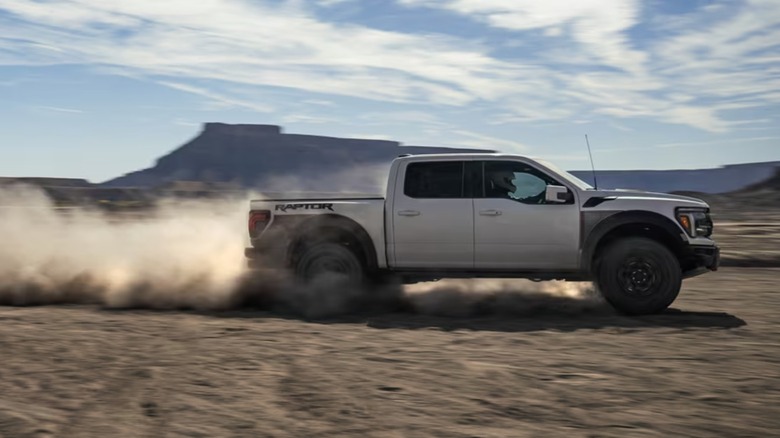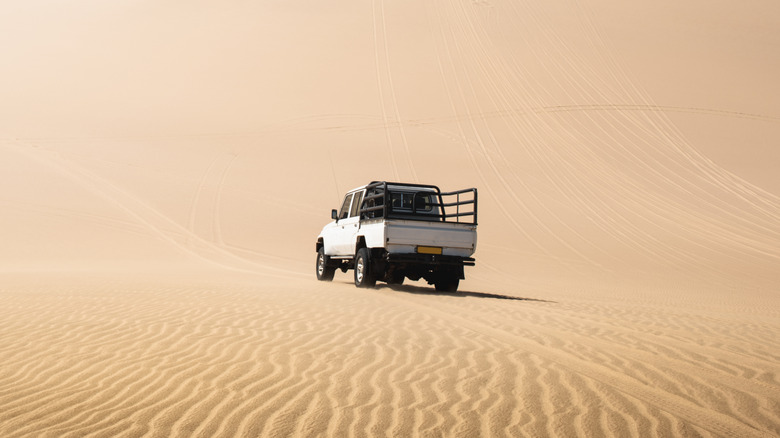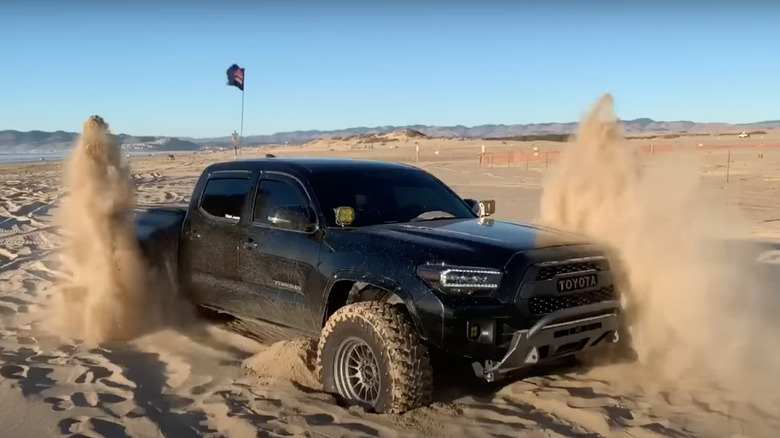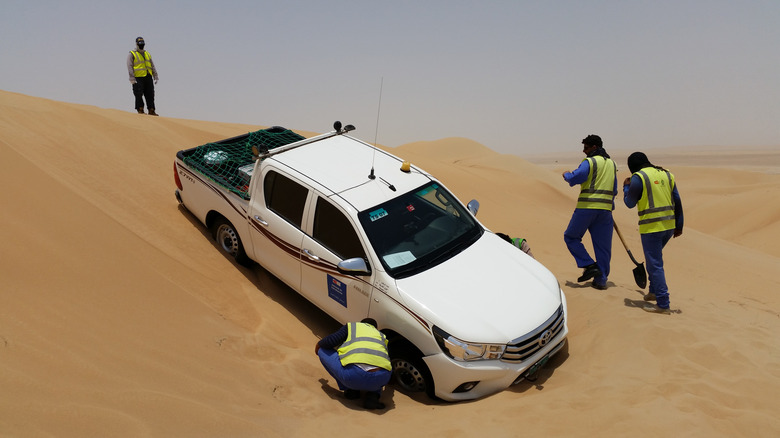The Right Way To Drive A Truck In The Sand So You Don't Get Stuck
We may receive a commission on purchases made from links.
Have you ever ridden on the back of a truck that was racing across an almost endless sea of sand? Do you dream of a glorious afternoon of surfing the sand dunes with your 4x4? Similar to the thrills of riding a roller coaster, driving on sand can be an electrifying experience. However, it can quickly turn horrifying if you don't take the right steps, especially if you find yourself stuck in the sand and not know what to do.
Now, it's important to know that there's no one, single setting to make your vehicle immune to the pitfalls of driving through sand. After all, there are different sand conditions (wet, dry, packed, or loose) that can all be in the same general area, which means you might not be as equipped to handle some conditions as well as others.
Before you even consider taking off into your next adventure, you can save yourself a lot of headache by simply preparing your vehicle properly, like adjusting your car's tire pressure. Knowing some useful strategies for sand driving on sand, like turning off traction control, as well as being aware of all the ways you can save yourself (and your truck) if you do end up stuck can keep you from panicking in an emergency. So, if you're determined to enjoy your upcoming ride through sandy dunes or beaches, here are all the ways to avoid getting stuck and what to do when it happens to you.
How to make your car sand-ready
To keep yourself from digging an unwanted hole in the sand with your truck, the first strategy is actually choosing the right one to bring with you. In reality, some trucks are just better suited to off-road fun more than others. If you had the choice, opting for adventure-ready vehicles with 4WD systems can give you significantly more power, control, and peace of mind in the sand. Unlike AWD vehicles, which are made for driving on regular roads, 4WDs thrive in more challenging terrain. You'll also want to make sure that you keep your truck as light as possible. After all, the heavier it is, the higher the risk that it sinks. So, it's best to leave unnecessary equipment at your camp site instead.
Next, it's best to lower your tire pressure to the right level, which is determined by the quality of the sand you're going to drive on. Depending on if it's hard-packed or loose, the ideal tire pressure will vary, but 20 PSI should be the sweet spot for many cars. On the other hand, you might want less pressure in general if you're expecting to drive on less packed sand. In some cases, certain beaches require drivers to adjust their air pressure to a specific level before being allowed near the water. For example, when visiting the National Seashore North Carolina, you'll need to bring your tire's PSI to 22.5.
Driving strategies in the sand
When it comes to driving on sand, there is one specific concept that you'll want drilled into your mind as a driver: momentum. Being able to dance with the interactions of your truck's mass and speed can determine how well you can go up hill, down hill, and even escape the treachery of being stuck in sand. To manage your car's momentum better, you'll want to disable your car's traction control, which keep your car moving instead of digging holes. While you're at it, you'll also want to consider turning off your car's stability control, which it shares a few similarities with. Additionally, when you're driving, make an effort to avoid doing extreme, sharp turns if you want to keep your car from accidentally flipping over.
If possible, it is best to also check out the local sand dune or beach's guidelines, which can include things like marked routes, speed limits, and off-limit areas. Typically, these areas are tagged for a reason, like having a history of accidents or being difficult for recovery. In addition, make sure to stay away from private property and protected wildlife areas, so you don't cause any trouble for the nearby community. That said, it's important to note that no matter how careful you are, there's always a chance that your car gets stuck in the sand for one reason or another. If you do find yourself in this situation, there are a couple of things you can still do.
What to do when you get stuck in the sand
In a moment of sand-induced crisis, the first thing you should take note of is the quality of the sand you're driving on. In general, the trick is being able to simulate a packed surface wherein your tires can generate some sort of traction. If it's a soft, flat area, put the truck in reverse, and try to drive over your previous tracks. In some cases, you might need to use car mat (or something similar), physically wet the sand, or tamper the sand manually. One popular tool to help stuck vehicles is the BUNKER INDUST Off-Road Tracking Boards. Retailing for $87.99, these tire traction ramps can help you get unstuck from sand, as well as mud and snow. It's no wonder that more than a thousand drivers have given it an impressive 4.7 stars on Amazon.
In more serious situations, you might need other trucks to give you a hand with tow straps. So if you're planning to drive on sand for the first time, try to enlist a friend with a 4x4 or get the number of an off-road recovery specialist in the area, just in case. But, if you're really craving some speed on the sand, you can always visit a tourist site with dedicated ATV, off-roading, or sand dune riding tours instead. And if you're worried about having to clean sand out of your car afterwards, we have a cleaning hack you might be interested in.



